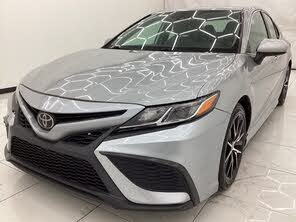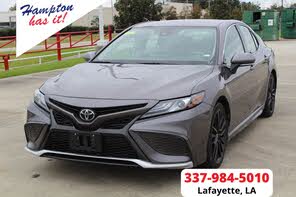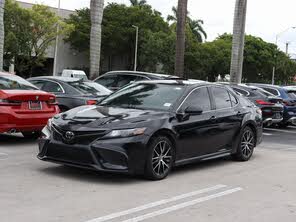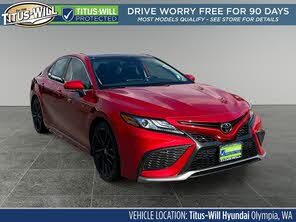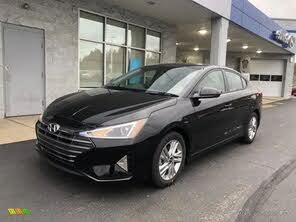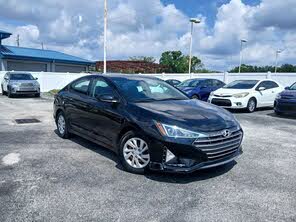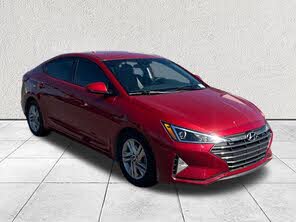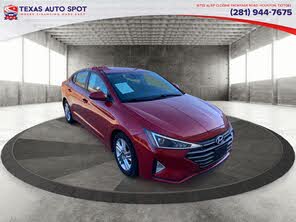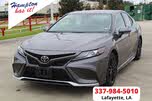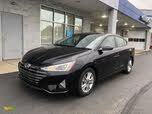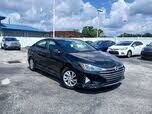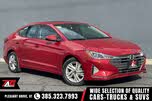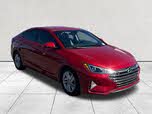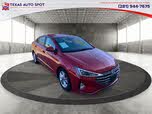2021 Toyota Camry vs 2020 Hyundai Elantra
Overview | |
MSRP$19,300 | MSRP$25,045 |
Listings1052 | Listings1445 |
Ratings & Reviews | |
User Reviews | User Reviews |
Expert reviews8.3 out of 10 | Expert reviews7.8 out of 10 |
Pros
Cons
| Pros
Cons
|
2020 Hyundai Elantra Reviews SummaryHyundai isn’t pulling any punches when it comes to the compact car segment, where value is of utmost importance. And though a completely redesigned 2021 Elantra is coming soon, the automaker bestows several value-enhancing improvements upon the outgoing 2020 Hyundai Elantra compact sedan. They include free scheduled maintenance, improved fuel economy ratings, and new standard safety features. | |
2021 Toyota Camry Reviews SummaryThe Toyota Camry has long been many new-car buyers’ default choice—but not because it’s interesting. Reliability and practicality have traditionally been the Camry’s strengths, not sportiness or style. Toyota tried to change that for the 2018 model year, when the Camry was last redesigned. The current-generation Camry adopted more extroverted styling, and engineers tried to make the driving experience more exciting, too. While Toyota’s approach has changed, the Camry still competes against the same array of midsize sedans, including the Honda Accord, Hyundai Sonata, Mazda 6, Nissan Altima, Subaru Legacy, and Volkswagen Passat. Changes for the 2021 model year include subtle styling tweaks, new infotainment displays, an upgrade to the Toyota Safety Sense 2.5+ (TSS 2.5+) package of driver aids, some changes to the dashboard trim, and the discontinuation of the Camry L trim level. That leaves the Camry LE as the new base trim level. The Camry offers buyers more choices than many rivals, encompassing three powertrains (inline-four, V6, and hybrid), six trim levels (LE, XLE, SE, SE Nightshade Edition, XSE, and TRD), and the choice of front-wheel drive (FWD) or all-wheel drive (AWD). Our test car was an AWD SE Nightshade Edition, positioned close to the middle of the lineup. | |
No video found | No video found |
Popular Features & Specs | |
Engine2.0L 147 hp I4 | Engine2.5L 203 hp I4 |
Drive TrainFWD | Drive TrainFWD |
Seating Capacity5 | Seating Capacity5 |
Horsepower147 hp @ 6200 rpm | Horsepower |
MPG City31 | MPG City28 |
MPG Highway41 | MPG Highway39 |
Engine | |
Engine Name2.0L 147 hp I4 | Engine Name2.5L 203 hp I4 |
Torque132 lb-ft @ 4500 rpm | Torque |
Horsepower147 hp @ 6200 rpm | Horsepower |
DrivetrainFWD | DrivetrainFWD |
Fuel Economy | |
MPG City31 | MPG City28 |
MPG Highway41 | MPG Highway39 |
Interior | |
Seating Capacity5 | Seating Capacity5 |
Safety | |
Front Crash Overall4 | Front Crash Overall5 |
Side Crash Overall4 | Side Crash Overall5 |
Dimensions & Capacity | |
Cargo Space14.4 cu ft | Cargo Space15.1 cu ft |
Curb Weight2844 lbs | Curb Weight3310 lbs |
Height56.5 in | Height56.9 in |
Length181.9 in | Length192.1 in |
Width70.9 in | Width72.4 in |
Wheelbase106.3 in | Wheelbase111.2 in |
Maximum Payload1080 lbs | Maximum Payload925 lbs |
Number of doors4 | Number of doors4 |
Overview | ||
MSRP | $19,300 | $25,045 |
Listings | ||
Ratings & Reviews | ||
User reviews | ||
Expert reviews | 8.3 out of 10Read full review | 7.8 out of 10Read full review |
Pros & cons | Pros
Cons
| Pros
Cons
|
Summary | Hyundai isn’t pulling any punches when it comes to the compact car segment, where value is of utmost importance. And though a completely redesigned 2021 Elantra is coming soon, the automaker bestows several value-enhancing improvements upon the outgoing 2020 Hyundai Elantra compact sedan. They include free scheduled maintenance, improved fuel economy ratings, and new standard safety features. | The Toyota Camry has long been many new-car buyers’ default choice—but not because it’s interesting. Reliability and practicality have traditionally been the Camry’s strengths, not sportiness or style. Toyota tried to change that for the 2018 model year, when the Camry was last redesigned. The current-generation Camry adopted more extroverted styling, and engineers tried to make the driving experience more exciting, too. While Toyota’s approach has changed, the Camry still competes against the same array of midsize sedans, including the Honda Accord, Hyundai Sonata, Mazda 6, Nissan Altima, Subaru Legacy, and Volkswagen Passat. Changes for the 2021 model year include subtle styling tweaks, new infotainment displays, an upgrade to the Toyota Safety Sense 2.5+ (TSS 2.5+) package of driver aids, some changes to the dashboard trim, and the discontinuation of the Camry L trim level. That leaves the Camry LE as the new base trim level. The Camry offers buyers more choices than many rivals, encompassing three powertrains (inline-four, V6, and hybrid), six trim levels (LE, XLE, SE, SE Nightshade Edition, XSE, and TRD), and the choice of front-wheel drive (FWD) or all-wheel drive (AWD). Our test car was an AWD SE Nightshade Edition, positioned close to the middle of the lineup. |
Video | No video found | No video found |
Popular Features & Specs | ||
Engine | 2.0L 147 hp I4 | 2.5L 203 hp I4 |
Drive Train | FWD | FWD |
Seating Capacity | 5 | 5 |
Horsepower | 147 hp @ 6200 rpm | |
MPG City | 31 | 28 |
MPG Highway | 41 | 39 |
Engine | ||
Engine Name | 2.0L 147 hp I4 | 2.5L 203 hp I4 |
Torque | 132 lb-ft @ 4500 rpm | |
Horsepower | 147 hp @ 6200 rpm | |
Drivetrain | FWD | FWD |
Fuel Economy | ||
MPG City | 31 | 28 |
MPG Highway | 41 | 39 |
Interior | ||
Seating Capacity | 5 | 5 |
Safety | ||
Front Crash Overall | 4 | 5 |
Side Crash Overall | 4 | 5 |
Dimensions & Capacity | ||
Cargo Space | 14.4 cu ft | 15.1 cu ft |
Curb Weight | 2844 lbs | 3310 lbs |
Height | 56.5 in | 56.9 in |
Length | 181.9 in | 192.1 in |
Width | 70.9 in | 72.4 in |
Wheelbase | 106.3 in | 111.2 in |
Maximum Payload | 1080 lbs | 925 lbs |
Number of doors | 4 | 4 |
The 2020 Hyundai Elantra had a bold and angular design carried over from its significant 2019 restyle. The geometric shapes in its headlights, fog lights, and wheels differentiated it from previous models, signaling Hyundai’s transition to more aggressive styling for the future. Available in six versions—SE, SEL, Value Edition, Eco, Limited, and Sport—the Elantra catered to a variety of tastes and price points, ranging from $19,300 to $24,150. Our test vehicle, a Limited trim with the Ultimate Package, stood at $27,630. Its black paint job sharply contrasted with chrome details, but opinions on its visual appeal varied among consumers. The interior saw an upscale redesign featuring silver trim accents and a more premium look, although some hard plastics remained to remind buyers of its economical roots.
By contrast, the 2021 Toyota Camry sought to erase memories of its prior generic designs through bold and detailed styling. The car's flared wheel arches and sleek lights gave it a wider stance. The SE, XSE, and TRD trims featured fake vents that added to the visual complexity, while the LE and XLE trims showcased a massive yet slightly cleaner grille. Built on the versatile TNGA-K platform, the Camry shared its bones with the Avalon and RAV4. Modest updates to the front fascia distinguished the 2021 model from its predecessor, while special editions like the Nightshade Edition, with its blacked-out trim and wheels, added flare. Interior styling was chaotic, blending various materials and textures, often to mixed reviews on consistency and quality.










Under the hood, the 2020 Hyundai Elantra offered a 147-horsepower, 2.0-liter four-cylinder engine paired with a brand new continuously variable transmission (CVT), replacing the previous six-speed automatic. The CVT increased the base price by $1,100 but aimed to improve efficiency. Eco and Sport trims provided unique powertrain options: a 1.4-liter turbocharged engine with 128 horsepower for the Eco and a 1.6-liter turbo delivering 201 horsepower for the Sport. The new CVT, boasting a chain belt and wide-ratio pulley system, was intended to enhance fuel efficiency but fell short in real-world testing, achieving only 29.3 mpg against an expected 34 mpg. Handling was hampered by a simple torsion beam axle rear suspension, though the Sport trim's independent suspension offered a marked improvement.
The 2021 Toyota Camry presented a diverse lineup of powertrains. The base Dynamic Force 2.5-liter four-cylinder engine produced 203 horsepower with FWD and slightly less with AWD. XSE models enjoyed a bump to 206 horsepower. A 3.5-liter V6 was available, yielding 301 horsepower and making the Camry stand out in a market shifting towards turbocharged engines. Additionally, the Camry Hybrid's 2.5-liter engine and electric motor delivered a combined 208 horsepower. The eight-speed automatic transmission was standard across these powertrains. Our SE Nightshade Edition with the base engine and AWD offered a surprisingly spirited drive, balancing ride quality and handling effectively. The TRD model added enhanced suspension and braking elements for a sportier experience. The AWD system, borrowed from the RAV4, could split torque 50-50 between front and rear wheels, reverting to FWD when additional traction was unnecessary.
In terms of interior space, the 2020 Hyundai Elantra comfortably accommodated four adults and provided adequate trunk space with 14.4 cubic feet. The Limited trim featured power driver’s seat adjustment, leather upholstery, and dual-zone automatic climate control. However, rear-seat climate vents were notably absent, and the rear passenger area felt less prioritized in terms of comfort. Interior storage was suitable for a compact car, with thoughtful details like a trunk grab handle.
The 2021 Toyota Camry excelled in rear seat headroom and legroom, although front seat comfort felt cramped by comparison. The cargo capacity stood at 15.1 cubic feet, overshadowed by the Honda Accord's 16.7 cubic feet but typical for its class. In-cabin storage was limited, with small cupholders and hard-to-reach door storage bins. Toyota’s inclusion of analog controls for key functions simplified usability, despite some layout issues. Higher trim levels also offered dual-zone automatic climate control.
The 2020 Hyundai Elantra came with a standard touchscreen infotainment system, starting at 5 inches for the SE trim and upgrading to a 7-inch display with the SEL trim, featuring Apple CarPlay, Android Auto, and SiriusXM satellite radio. Higher trims, like the Limited, provided an 8-inch touchscreen with navigation and Blue Link connectivity, alongside wireless smartphone charging and a premium Infinity sound system. The infotainment system was user-friendly, with shortcut buttons and responsive voice recognition.
The 2021 Toyota Camry included a 7-inch touchscreen across the board, with Apple CarPlay and Android Auto, and higher trims featured a 9-inch display with navigation and a nine-speaker JBL audio system. Notable additions included a 10-inch head-up display for XSE and XLE trims. The infotainment interface was functional but not particularly standout due to plain graphics, and the port locations were fixed across all trim levels, offering limited flexibility.
The 2020 Hyundai Elantra included Hyundai Smart Sense as standard, encompassing forward-collision warning, automatic emergency braking, lane departure warning, lane-keeping assist, and a driver attention monitor. Higher trims offered blind-spot warning, rear cross-traffic alert, adaptive cruise control, and a pedestrian detection system. It achieved a Top Safety Pick rating from the IIHS with LED headlights and a four-star NHTSA rating, despite some rear-door intrusion concerns during side-impact tests.
For 2021, the Toyota Camry was equipped with TSS 2.5+, featuring adaptive cruise control, forward-collision warning with pedestrian detection, automatic high beams, and traffic-sign recognition. Toyota enhanced these systems for better performance, including automatic acceleration for lane changes and improved forward-collision detection for cyclists. The Camry also introduced a Rear Seat Reminder feature. It earned a Top Safety Pick+ from the IIHS and a five-star overall rating from NHTSA.
CarGurus highlights

According to CarGurus experts, the overall rating for the 2020 Hyundai Elantra is an 8.3 out of 10, while the 2021 Toyota Camry scores a 7.8 out of 10. Based on these ratings, the Hyundai Elantra emerges as the better all-around choice, offering a compelling blend of affordability, technology, and safety that slightly outpaces the Camry’s broader appeal. For those in the market for a new vehicle, the 2020 Elantra stands as a more favorable option concerning consumer ratings and overall value.
Choose the 2021 Toyota Camry if:
- You seek a midsize sedan with a broad range of powertrain options, including a V6 and hybrid.
- You want a car with excellent rear passenger space and modern safety enhancements.
- You appreciate a stylish, sporty design with advanced safety ratings.
Choose the 2020 Hyundai Elantra if:
- You prioritize affordability with a high level of standard safety features and technology.
- You prefer a compact car with a bold, angular design.
- You value a user-friendly infotainment system with accessible controls and connectivity options.
CarGurus highlights

According to CarGurus experts, the overall rating for the 2020 Hyundai Elantra is an 8.3 out of 10, while the 2021 Toyota Camry scores a 7.8 out of 10. Based on these ratings, the Hyundai Elantra emerges as the better all-around choice, offering a compelling blend of affordability, technology, and safety that slightly outpaces the Camry’s broader appeal. For those in the market for a new vehicle, the 2020 Elantra stands as a more favorable option concerning consumer ratings and overall value.
Choose the 2021 Toyota Camry if:
Shop Now- You seek a midsize sedan with a broad range of powertrain options, including a V6 and hybrid.
- You want a car with excellent rear passenger space and modern safety enhancements.
- You appreciate a stylish, sporty design with advanced safety ratings.
Choose the 2020 Hyundai Elantra if:
Shop Now- You prioritize affordability with a high level of standard safety features and technology.
- You prefer a compact car with a bold, angular design.
- You value a user-friendly infotainment system with accessible controls and connectivity options.

By: CarGurus + AI
At CarGurus, our team of experienced automotive writers remain at the heart of our content operation, conducting hands-on car tests and writing insightful guides that are backed by years of industry experience. To complement this, we are harnessing AI to make our content offering more diverse and more helpful to shoppers than ever. To achieve this, our AI systems are based exclusively on CarGurus content, ratings and data, so that what we produce is both unique to CarGurus, and uniquely helpful to car shoppers.




